By Mike Tanner, Photos By Kevin Gaydosh
NAGS HEAD, NC -- There's an old saying among golfers in Scotland, "Nae wind, nae gowf." The same can be said about playing Nags Head Golf Links on North Carolina's Outer Banks.
Just a few miles south of the place where the Wright Brothers followed the wind to pioneer powered flight, golfers must constantly factor windage to determine how to hit their shots on this Scottish-styled layout hard by the shores of Roanoke Sound.
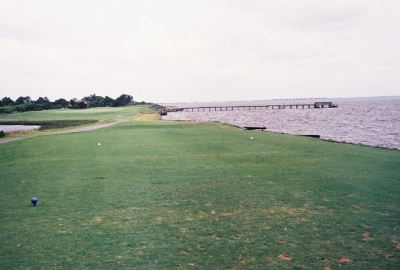 |
| View from the 15th tee at Nags Head Golf Links. |
Head Professional Dave Mullineaux points out, "The wind helps protect par here. The course isn't very long and a good player can eat it up on a calm day." As Outer Banks residents and experienced visitors will tell you, there aren't many days that the wind doesn't blow on this narrow strand of barrier islands.
Architect Bob Moore laid out the course in a roughly figure eight shape, so that regardless of the wind's direction, it helps on some holes and hurts on others. Nags Head Golf Links measures just 6,126 yards from the back tees, with a stout slope of 138. In a 1991 feature article, Golf Digest called it the longest 6,126 yards you'll ever play.
Opened in 1987, Nags Head Golf Links has matured like a well-balanced fine wine. The manicured Bermudagrass fairways offer a firm foundation and fair lies where the ball sits up well. Bentgrass greens, although spotted in places by Poa annua following an exceptionally cool and wet winter and spring, offer consistent speed and true putting surfaces. The course's beautifully landscaped flowerbeds contrast nicely with unmaintained areas of sand, wind-sculpted shrubs and trees, and spiky native grasses.
A trio of holes provides a pleasant introduction to this shotmaker's golf course. Playing from an elevated tee that offers a view of Roanoke Sound to the west the 292-yard, par-4 first hole invites players to use a fairway metal or long iron for the tee shot. Favor the right hand side of the landing area to avoid playing the approach shot over a dense thicket of gnarly flora that protects the left side of the green.
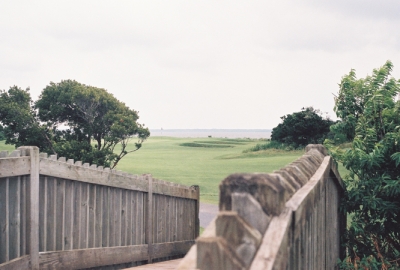 |
| Bridge over the burn on the 4th hole. |
Following the first hole, a straightforward par-5 and a short par-3 featuring a lagoon between the tee and green allow golfers the opportunity hit a variety of clubs and limber up for the challenge that arrives on the tee of hole number four.
On the day of this review, a two-club wind was blowing steadily from the southwest, directly into the face of golfers teeing off on this 349-yard par-4 hole. A narrow burn (to use the Scottish vernacular) cuts diagonally across the fairway 210 yards from the back tees. Deciding whether to drive over the hazard or lay up is complicated because the right side of the fairway over the water presents a shallow target backed by a thicket of un-maintained sandy scrub.
A safe play that doesn't challenge the hazard leaves a longer approach shot to the green, which offers a view of Roanoke Sound behind it. Players who drive over the water are rewarded with a short iron approach, but their tee shots must be absolutely precise in both distance and direction.
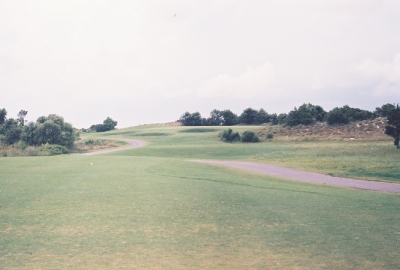 |
| Looking towards the green on the 17th hole, a 160 yard par three. |
The par-5 fifth hole is the number-one handicap hole at Nags Head Golf Links. Playing 513 yards, it runs alongside Roanoke Sound from tee to green with a sizable lagoon affecting strategy on the second shot. Southwest winds blow tee balls to the right side of the fairway, which offers plenty of room, but cuts off a direct approach to the green. A short drive or one that's too far right will encourage a lay up shot short of the lagoon and a consequently longer approach shot. A tee shot boomed into ideal position on the fairway turns the player loose to go for the green in two and the potential for an eagle or birdie.
Like the fourth hole, number eight is a great risk-reward golf hole. The 360-yard, par-4 features a nearly 90-degree dogleg right and a wide lagoon between the tee and landing area. The optimal approach to the green requires a drive over the longest expanse of water to the left side of the fairway, but trying to play safe isn't completely without risk. Another of those pesky un-maintained areas intrudes into the fairway on the right beyond the water, so the short play requires precise placement.
The front nine finishes with a challenging 359-yard, par-4 paralleling Roanoke Sound on the left from tee to green. Tee shots must negotiate a small hillock on the right side of the landing area, while approach shots have to be launched over a patch of low shrubs and sand that partially obscures the view of the putting surface from players in the fairway.
The back nine at Nags Head Golf Links features three par-3 holes-the tenth, fifteenth and seventeenth. Number ten is 173 yards from the back tees and depending on the wind, it can be played with anything from a fairway metal to an 8-iron.
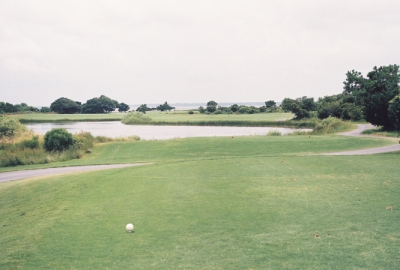 |
| You can't see the green from the tee of the 360 yard, par four 8th hole, but there're still plenty of choices on where to place the shot. |
That's what makes Nags Head Golf Links unique according to Head Professional Dave Mullineaux. "The course doesn't play the same way two days in a row."
The par-4 eleventh hole doglegs to the left, but woe to the tee shot that strays too far to port, for a watery grave waits there.
The twelfth hole, also a par-4, features a blind tee shot over a hill with a large pond between the landing area and green. After hitting their tee shots, golfers push the button on a warning sign to indicate that they are playing the hole hidden from view. Pressing the button mounted on a post next to the cart path at the exit to the landing area lets the following group know that it's safe to tee off.
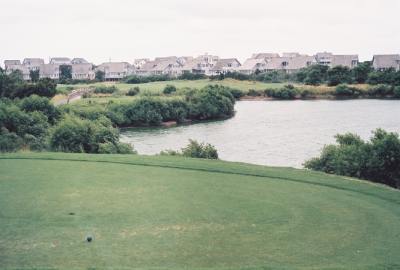 |
| Another tough tee shot greets you at the 11th hole. |
The thirteenth hole is a risk-reward par-5 featuring a tight landing area off the tee and water guarding the front of the green. Fourteen is a 317-yard, par-4 that provides a little breather before the course leads players back to the edge of Roanoke Sound.
Number 15 is a looong par-3, especially when the wind is out of the southwest. At 221 yards from the back tees and completely exposed to wind off Roanoke Sound on the right from tee to green, there are times when a driver is barely enough club to reach the putting surface. Considered by many to be the course's signature hole, it is undoubtedly one of the most memorable golf holes you'll ever play.
Another par-3, the seventeenth hole is exceptionally picturesque. Standing on the elevated green, protected by three deep bunkers in front and a copse of tangled brush to the rear, players are treated to panoramic views of Roanoke Sound. It's no wonder that Golf Digest called Nags Head Golf Links' soundside holes among the most beautiful in the Eastern United States.
The eighteenth hole, a 583-yard, par-5 that stretches for 583 yards with the Roanoke Sound all along the right side, offers a generous landing area for tee shots. Then comes decision-making time, because the fairway narrows to an hourglass shape pinched between two un-maintained areas where most player's would hit their second shots.
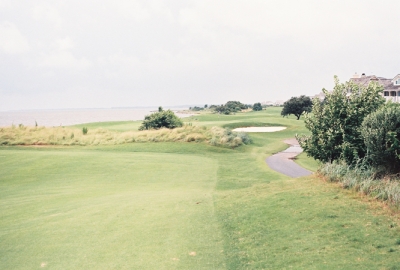 |
| Plenty of work remains on the 2nd shot to the 359 yard, par four 9th hole. |
Says Mullineaux, "The second shot is key. If you're not confident about getting past the trouble, lay up and then try to par the hole with your wedge and one putt."
Once you've holed out on eighteen and added up your score, you'll probably think of a few places where you could have shaved some strokes from your total.
"A lot of folks play it once and say they want to come back and have at it again," according to Mullineaux.
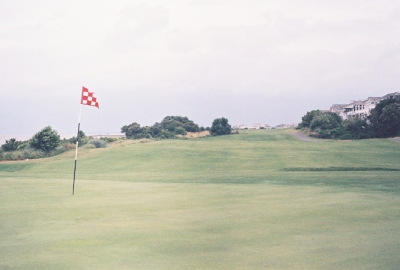 |
| Finishing up on the 18th green. |
There is some advantage to having local knowledge, but any golfer who knows the joy of hitting a well-struck shot to a specific target will enjoy playing Nags Head Golf Links. You don't have to bomb your drives or fly every approach shot to the green to enjoy your round. The dune-like surroundings and ever-present winds will make you feel like you've been transported to the bonny land where the game began.
Nags Head Golf Links is affiliated with Club Corp and is a member of the Outer Banks Golf Association. Golf packages with overnight accommodations can be arranged by calling 800-916-6244. Information is available at www.outerbanksgolf.com.
Details:
Nags Head Golf Links
5615 South Seachase Drive
Nags Head, NC 27959
Phone: (252) 441-8073; Toll Free: (800) 851-9404
Located on Rt. 158 at Milepost 15 1/2
Website: www.nagsheadgolflinks.com
Course Architect: Bob Moore
Director of Golf: Craig Menne
Head Golf Professional: Dave Mullineaux
Superintendent: Craig Doxey
| Tees | Yardage/Slope | Rating |
| Championship | 6126/138 | 71.2 |
| Blue | 5717/128 | 69.4 |
| White | 5354/119 | 67.3 |
| Ladies White | 5354/139 | 73.4 |
| Red | 4415/117 | 68.5 |
Rates:
Rates vary according to time of year, ranging from $45 in winter, to $110 in the summer season, which runs from June 29th to August 16th. Twilight and Junior rates also available. Consult the website for more information.
All rates include cart and taxes.
| Related Links | Comments on this article? | |
|
Maryland National Golf Club Hollow Creek Golf Club Rocky Gap Resort PB Dye Golf Club in Ijamsville Whiskey Creek Golf Club |
E-mail Jeff Rendall, Editor: jrendall@golftheunitedstates.com |












